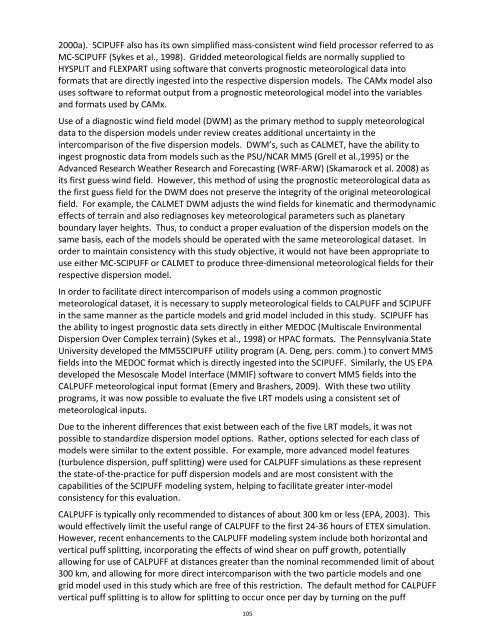Documentation of the Evaluation of CALPUFF and Other Long ...
Documentation of the Evaluation of CALPUFF and Other Long ...
Documentation of the Evaluation of CALPUFF and Other Long ...
You also want an ePaper? Increase the reach of your titles
YUMPU automatically turns print PDFs into web optimized ePapers that Google loves.
2000a). SCIPUFF also has its own simplified mass‐consistent wind field processor referred to as<br />
MC‐SCIPUFF (Sykes et al., 1998). Gridded meteorological fields are normally supplied to<br />
HYSPLIT <strong>and</strong> FLEXPART using s<strong>of</strong>tware that converts prognostic meteorological data into<br />
formats that are directly ingested into <strong>the</strong> respective dispersion models. The CAMx model also<br />
uses s<strong>of</strong>tware to reformat output from a prognostic meteorological model into <strong>the</strong> variables<br />
<strong>and</strong> formats used by CAMx.<br />
Use <strong>of</strong> a diagnostic wind field model (DWM) as <strong>the</strong> primary method to supply meteorological<br />
data to <strong>the</strong> dispersion models under review creates additional uncertainty in <strong>the</strong><br />
intercomparison <strong>of</strong> <strong>the</strong> five dispersion models. DWM’s, such as CALMET, have <strong>the</strong> ability to<br />
ingest prognostic data from models such as <strong>the</strong> PSU/NCAR MM5 (Grell et al.,1995) or <strong>the</strong><br />
Advanced Research Wea<strong>the</strong>r Research <strong>and</strong> Forecasting (WRF‐ARW) (Skamarock et al. 2008) as<br />
its first guess wind field. However, this method <strong>of</strong> using <strong>the</strong> prognostic meteorological data as<br />
<strong>the</strong> first guess field for <strong>the</strong> DWM does not preserve <strong>the</strong> integrity <strong>of</strong> <strong>the</strong> original meteorological<br />
field. For example, <strong>the</strong> CALMET DWM adjusts <strong>the</strong> wind fields for kinematic <strong>and</strong> <strong>the</strong>rmodynamic<br />
effects <strong>of</strong> terrain <strong>and</strong> also rediagnoses key meteorological parameters such as planetary<br />
boundary layer heights. Thus, to conduct a proper evaluation <strong>of</strong> <strong>the</strong> dispersion models on <strong>the</strong><br />
same basis, each <strong>of</strong> <strong>the</strong> models should be operated with <strong>the</strong> same meteorological dataset. In<br />
order to maintain consistency with this study objective, it would not have been appropriate to<br />
use ei<strong>the</strong>r MC‐SCIPUFF or CALMET to produce three‐dimensional meteorological fields for <strong>the</strong>ir<br />
respective dispersion model.<br />
In order to facilitate direct intercomparison <strong>of</strong> models using a common prognostic<br />
meteorological dataset, it is necessary to supply meteorological fields to <strong>CALPUFF</strong> <strong>and</strong> SCIPUFF<br />
in <strong>the</strong> same manner as <strong>the</strong> particle models <strong>and</strong> grid model included in this study. SCIPUFF has<br />
<strong>the</strong> ability to ingest prognostic data sets directly in ei<strong>the</strong>r MEDOC (Multiscale Environmental<br />
Dispersion Over Complex terrain) (Sykes et al., 1998) or HPAC formats. The Pennsylvania State<br />
University developed <strong>the</strong> MM5SCIPUFF utility program (A. Deng, pers. comm.) to convert MM5<br />
fields into <strong>the</strong> MEDOC format which is directly ingested into <strong>the</strong> SCIPUFF. Similarly, <strong>the</strong> US EPA<br />
developed <strong>the</strong> Mesoscale Model Interface (MMIF) s<strong>of</strong>tware to convert MM5 fields into <strong>the</strong><br />
<strong>CALPUFF</strong> meteorological input format (Emery <strong>and</strong> Brashers, 2009). With <strong>the</strong>se two utility<br />
programs, it was now possible to evaluate <strong>the</strong> five LRT models using a consistent set <strong>of</strong><br />
meteorological inputs.<br />
Due to <strong>the</strong> inherent differences that exist between each <strong>of</strong> <strong>the</strong> five LRT models, it was not<br />
possible to st<strong>and</strong>ardize dispersion model options. Ra<strong>the</strong>r, options selected for each class <strong>of</strong><br />
models were similar to <strong>the</strong> extent possible. For example, more advanced model features<br />
(turbulence dispersion, puff splitting) were used for <strong>CALPUFF</strong> simulations as <strong>the</strong>se represent<br />
<strong>the</strong> state‐<strong>of</strong>‐<strong>the</strong>‐practice for puff dispersion models <strong>and</strong> are most consistent with <strong>the</strong><br />
capabilities <strong>of</strong> <strong>the</strong> SCIPUFF modeling system, helping to facilitate greater inter‐model<br />
consistency for this evaluation.<br />
<strong>CALPUFF</strong> is typically only recommended to distances <strong>of</strong> about 300 km or less (EPA, 2003). This<br />
would effectively limit <strong>the</strong> useful range <strong>of</strong> <strong>CALPUFF</strong> to <strong>the</strong> first 24‐36 hours <strong>of</strong> ETEX simulation.<br />
However, recent enhancements to <strong>the</strong> <strong>CALPUFF</strong> modeling system include both horizontal <strong>and</strong><br />
vertical puff splitting, incorporating <strong>the</strong> effects <strong>of</strong> wind shear on puff growth, potentially<br />
allowing for use <strong>of</strong> <strong>CALPUFF</strong> at distances greater than <strong>the</strong> nominal recommended limit <strong>of</strong> about<br />
300 km, <strong>and</strong> allowing for more direct intercomparison with <strong>the</strong> two particle models <strong>and</strong> one<br />
grid model used in this study which are free <strong>of</strong> this restriction. The default method for <strong>CALPUFF</strong><br />
vertical puff splitting is to allow for splitting to occur once per day by turning on <strong>the</strong> puff<br />
105

















